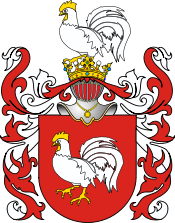
Mikołaj Kiczka
Encyclopedia

In 1421–1422 together with Władysław Oporowski
Władysław Oporowski
Władysław Oporowski was a Polish medieval political and religious leader. Deputy Chancellor of Poland , Bishop of Kujawy , archbishop of Gniezno and primate of Poland...
and Mikołaj Trąba he represented Poland and the Polish king Władysław Jagiełło in the process between Poland and the Teutonic Order before the Holy See
Holy See
The Holy See is the episcopal jurisdiction of the Catholic Church in Rome, in which its Bishop is commonly known as the Pope. It is the preeminent episcopal see of the Catholic Church, forming the central government of the Church. As such, diplomatically, and in other spheres the Holy See acts and...
in Rome. In 1427 he took part in the border delineation between Poland and the Order.
Archdeacon
Archdeacon
An archdeacon is a senior clergy position in Anglicanism, Syrian Malabar Nasrani, Chaldean Catholic, and some other Christian denominations, above that of most clergy and below a bishop. In the High Middle Ages it was the most senior diocesan position below a bishop in the Roman Catholic Church...
of Gniezno
Gniezno
Gniezno is a city in central-western Poland, some 50 km east of Poznań, inhabited by about 70,000 people. One of the Piasts' chief cities, it was mentioned by 10th century A.D. sources as the capital of Piast Poland however the first capital of Piast realm was most likely Giecz built around...
. Vicar
Vicar
In the broadest sense, a vicar is a representative, deputy or substitute; anyone acting "in the person of" or agent for a superior . In this sense, the title is comparable to lieutenant...
of Poznań
Poznan
Poznań is a city on the Warta river in west-central Poland, with a population of 556,022 in June 2009. It is among the oldest cities in Poland, and was one of the most important centres in the early Polish state, whose first rulers were buried at Poznań's cathedral. It is sometimes claimed to be...
(1423–1428).
He used the Kur coat of arms
Kur coat of arms
Kur is a Polish coat of arms. It was used by several noble families forming a Clan of Kur in the times of the Polish-Lithuanian Commonwealth. It is noted during the reign of the Jagiellon dynasty and illustrated with its original name in the work of Bartosz Paprocki "Herby Rycerstwa Polskiego" in...
.

